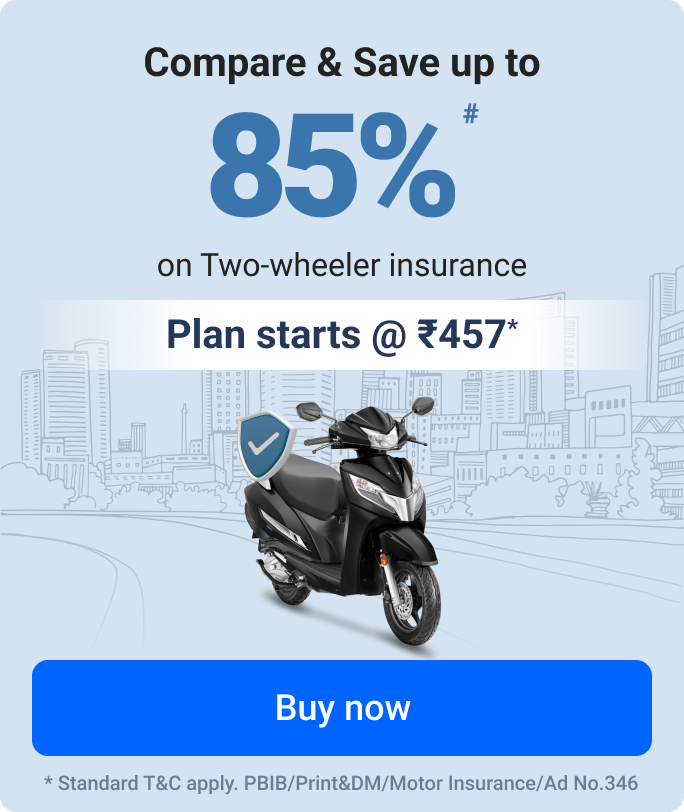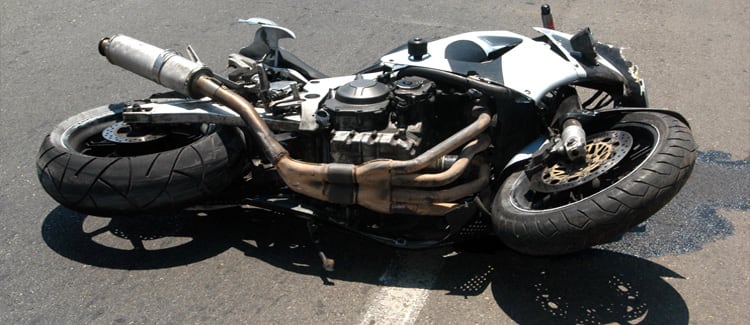What is IDV and NCB in Two Wheeler Insurance?
Insured Declared Value has a direct impact on the cost of your bike insurance premium. It is the maximum sum insured amount that a vehicle insurance provider will give to the policyholder while filing the claim. The insurance company fixed this amount, which is similar to the vehicle’s market value and it will change at the time of policy renewal.
Basically, it is the present market value of your two-wheeler. In cases, where your 2-wheeler is declared as a total loss then the compensation provided by your insurer will be similar to the Insured Declared Value of your 2-wheeler.
The formula to derive to the insured declared value is as follows - Manufacturer's listed selling price - the depreciation amount of depreciation. The cost of non-factory fitted accessories is calculated separately. All these factors play an important role in determining the premium of your bike insurance policy, and this information will help you find the bike insurance quotation.
Whereas a No-claim-bonus is accumulated every year, and depending on the number of claim-free years you will earn the discount. Insured members who have maintained a good driving record can earn up to a maximum of 50% no-claim discount, taking into consideration your age, demographics, and profession among other factors.
Insured Declared Value and the No-claim-bonus are two important factors of every bike insurance. The IDV of a two wheeler is fixed at the time of renewing or purchasing the insurance policy. The sum assured value is based on the Insured Declared Value of the two-wheeler as stated by its manufacturer after deducting the depreciation on its parts.
If the age of your two-wheeler is more than 5 years or if the model of the 2-wheeler has become obsolete, then its Insured Declared Value can be mutually decided between the insured and the vehicle insurance provider.
No Claim Bonus in Two Wheeler Insurance
NCB is the short form of No Claim Bonus. Every two wheeler insurance holder is eligible for NCB if no claim has been registered in the previous policy year.
In some cases, the insured person may decide to restrain from filing a claim and bear the bike repair expenses on their own. In such cases, the insured is entitled to NCB that is a discount on the two-wheeler insurance premium at the time of renewal of bike insurance policy.
No-claim-discount is valid only on the 'Own Damage Premium' of a 2 wheeler insurance policy. The discount will range from 20% to 50%.
Can NCB be Transferred to Another Person?
No claims bonus is usually offered on the insured bike and not the driver. It is possible to switch it while you are renewing your two-wheeler policy. And your previous insurance company will provide you a 'No Claims Certificate' at no additional cost.
Importance of No Claim Bonus in Deciding the Two Wheeler Insurance Premium
No-Claim-Bonus plays an important role in trimming down the two wheeler insurance premium amount. It is an effective way to gradually reduce the cost of the premium. The percentage of NCB increases for the subsequent claim-free years.
The No-claim-bonus that is applicable is listed below:
|
Own Damage Claim Free Years |
No Claim Bonus |
|
No claim filed in the 1st year |
20 |
|
No claim filed for 2 continuous years |
25 |
|
No claim filed for 3 continuous years |
35 |
|
No claim filed for 4 continuous years |
45 |
|
No claim filed for 5 continuous years |
50 |
| You may like to Read: Tips to Reduce Two Wheeler Premium |
Does IDV Matter in Bike Insurance?
IDV in bike insurance is one of the most important factors in deciding the bike insurance premium that one needs to pay at the time of renewing or purchasing the 2-wheeler insurance policy. Basically, your bike’s Insured Declared Value is indicative of the current market value of your bike. It is the maximum amount that the insurer will pay to the policyholder in case of constructive total loss or theft. Read on to know the relevance of the Insured Declared Value in a vehicle insurance policy or a bike insurance policy.
How to Know the IDV of my Bike?
The IDV of the two-wheeler is calculated on the basis of the selling price of the two-wheeler and after deducting the depreciation value. As the age of the bike increases, its IDV will keep reducing. The formula to calculate the IDV of a two-wheeler is as follows:
Insured Declared Value = (Company’s listed selling price – Depreciation value) + (the cost of bike’s accessories that are excluded from the listed selling price – their depreciation value)
The schedule of depreciation and IDV based on the age of the bike are as follows:
|
Age of the Two-Wheeler |
Rate of Depreciation |
Insured Declared Value |
|
Less than six months |
5 percent |
95% of the bike’s ex-showroom value |
|
From 6 months to 1 year |
15 percent |
85% of the bike’s ex-showroom value |
|
From 1 year to 2 years |
20 percent |
80% of the bike’s ex-showroom value |
|
From 2 years to 3 years |
30 percent |
70% of the bike’s ex-showroom value |
|
From 3 years to 4 years |
40 percent |
60% of the bike’s ex-showroom value |
|
From 4 years to 5 years |
50 percent |
50% of the bike’s ex-showroom value |
In addition to the ex-showroom price and the depreciation rate of the bike, your bike insurer may also take into consideration other factors such as the bike’ make and model, registration details, and manufacturer details to determine the Insured Declared V.
Is Higher IDV better for Two-Wheelers?
The premium of a bike insurance policy primarily depends on the Insured declared value, especially if you have purchased a comprehensive two wheeler insurance policy.
Thus, the lesser the age of your bike, the higher will be the IDV, which in turn means a higher premium rate. As the bike ages, the lesser will be the IDV, which would mean a lower payable premium.
Moreover, there are various other factors that are considered to calculate the two-wheeler insurance quotation for a comprehensive bike wheeler insurance policy. These factors include the bike’s manufacturing year, add-on features, No Claim Bonus, the geographical location of the insured person, etc.
Should I Increase IDV for Your Two-Wheeler?
Whosoever wants to buy or renew a bike insurance policy is required to declare the correct IDV of their bike. It is essential to declare the correct Insured Declared Value because it will have a direct impact on the premium amount and the compensation amount that you will receive in case there is any damage or theft or a constructive total loss of the two-wheeler.
If your declared IDV that is lower than your bike’s current market value, your insurance company will give you a lower two-wheeler insurance premium quotation. And if you file a bike theft claim or a constructive total loss claim, the compensation amount will be quite less, which would mean significant losses.
Whereas, if your declared IDV that is higher than your bike’s current market value, the insurer will charge you with a higher premium amount. Therefore, it is important to evaluate the IDV correctly and declare the current IDV of your insured two-wheeler.
What Should be the IDV of My Bike?
If you want to know the correct IDV of your two-wheeler then you can also do it online with the help of a two wheeler insurance premium calculator. It is easily available on the official websites of the vehicle insurance companies and on aggregator’s websites. With this online tool, you can easily calculate the policy premium. Prospective buyers and customers can utilize this online tool free of cost.
To calculate the premium online, you just need to visit the insurer’s official website provide the required details, and you will know your two wheeler's exact IDV.
In a Nutshell
By now you must be clear that both NCB and the IDV play a crucial role in deciding the bike insurance premium. Therefore, it is your responsibility to declare the correct value if you do not want to pay any extra amount. You can also seek advice from your insurance provider regarding the same. And choose a policy that offers you NCB and IDV of your bike.
^The renewal of insurance policy is subject to our operations not being impacted by a system failure or force majeure event or for reasons beyond our control. Actual time for a transaction may vary subject to additional data requirements and operational processes.
^The buying of Insurance policy is subject to our operations not being impacted by a system failure or force majeure event or for reasons beyond our control. Actual time for transaction may vary subject to additional data requirements and operational processes.
#Savings are based on the comparison between highest and the lowest premium for own damage cover (excluding add-on covers) provided by different insurance companies for the same vehicle with the same IDV and same NCB.
*TP price for less than 75 CC two-wheelers. All savings are provided by insurers as per IRDAI-approved insurance plan. Standard T&C apply.
*Rs 538/- per annum is the price for third party motor insurance for two wheelers of not more than 75cc (non-commercial and non-electric)
#Savings are based on the comparison between the highest and the lowest premium for own damage cover (excluding add-on covers) provided by different insurance companies for the same vehicle with the same IDV and same NCB.
*₹ 1.5 is the Comprehensive premium for a 2015 TVS XL Super 70cc, MH02(Mumbai) RTO with an IDV of ₹5,895 and NCB at 50%.
*Rs 457/- per annum is the price for the third-party motor insurance for private electric two-wheelers of not more than 3KW (non-commercial).The list of insurers mentioned are arranged according to the alphabetical order of the names of insurers respectively.Policybazaar does not endorse, rate or recommend any particular insurer or insurance product offered by any insurer. The list of plans listed here comprise of insurance products offered by all the insurance partners of Policybazaar. For complete list of insurers in India refer to the Insurance Regulatory and Development Authority of India website www.irdai.gov.in




























